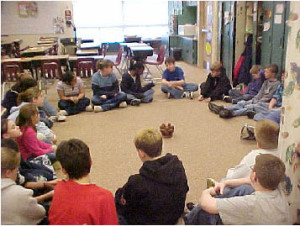 “Before we had circles we didn’t feel like our voices mattered. Now the violence and fighting have stopped. We all come together. A lot of us want to change the world.” —A 15-year-old Bengali girl at Hamtramck High School, in Hamtramck, Michigan, USA
“Before we had circles we didn’t feel like our voices mattered. Now the violence and fighting have stopped. We all come together. A lot of us want to change the world.” —A 15-year-old Bengali girl at Hamtramck High School, in Hamtramck, Michigan, USA
The above is from a student interview in a new article, "Restorative Practices: Giving Everyone a Voice to Create Safer, Saner School Communities," by Laura Mirsky, in the new issue of The Prevention Researcher, a quarterly US journal that focuses on successful adolescent development and serves professionals who work with young people.
Mirsky, assistant director of communications and technology for the IIRP, interviewed educators and students at schools using restorative practices. She concludes that “although formal research is just beginning in this area, early indications and anecdotal evidence suggest that restorative practices, by intentionally promoting open communication, enhance relationships and thereby improve school climate, discipline and safety.”
The article begins:
An art class at an inner-city high school is so chaotic the room looks like it’s been ransacked. Students wear music headphones and ignore the teacher. There are frequent shoving matches. The young, inexperienced teacher is at her wit’s end.
The assistant principal decides to hold a “talking circle” to address the problem. He tries passing around a ball as a “talking piece” (with only the person holding it allowed to speak). The kids jokingly toss it around the room. The assistant principal perseveres. When the students finally realize that he is trying to create an environment for them to solve problems, not just cast blame and mete out punishment, they open up and begin talking about what’s happening in the anarchic classroom. Soon they’re discussing their love of art and career goals.
One student, however, refuses to participate, goofing off and throwing the ball on the floor. Fed up, another student finally tells him, “Knock it off. Yeah, you’re funny, but you do this every day, and you make class impossible.” Surprising everyone, the boy asks for the ball and says, “OK, but when you guys laugh at me, you encourage me.” Chastened by his peers, the boy now stops interrupting the circle process.
As the circle continues, the students tell the teacher they think the class is childish, not challenging. Shocked, she replies, “I tried advanced activities, but you destroyed the materials and refused to participate!” The students admit she is right. The teacher says she’ll try more sophisticated projects if the students make a commitment to support each other to behave maturely and respect the materials. They agree to this.
In the circle, the students develop a plan to turn the class around, discussing how to help the “class clown” behave himself, and making a commitment to respect the art materials and take their work seriously. The next week, the class starts a sculpture lesson. Ultimately, the students keep their commitments and the class begins to function as an art class (Costello, Wachtel, & Wachtel, 2010).
The story above, which took place at West Philadelphia High School, in inner-city Philadelphia, depicts an example of restorative practices, an approach to positive school-wide behavior support that creates environments based on communication, mutual understanding, and respect.
This article seeks to familiarize readers with the philosophy and processes of restorative practices as employed in K-12 education. The author spoke to educators and students at schools where the practices are being implemented and relates their stories about how they are employing the practices, as well as their views on the practices’ effectiveness. Although formal research is just beginning in this area, early indications and anecdotal evidence suggest that restorative practices, by intentionally promoting open communication, enhance relationships and thereby improve school climate, discipline, and safety.
Read the the full article here.
Reference:
Costello, B., Wachtel, J., & Wachtel, T. (2010). Restorative Circles in Schools: Building Community and Enhancing Learning. Bethlehem, PA: International Institute for Restorative Practices.
